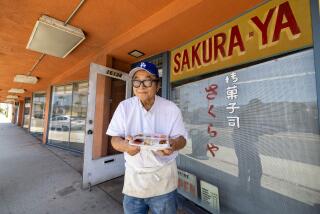Ancient Craft Gets a Captive Audience
OSAKA, Japan â Across Japan, traditional craftsmen are struggling to find young people willing to carry on their arts. But one centuries-old legacy has found a pool of talent not likely to dry up for quite some time -- prisoners.
In a program meshing the need of artisans to find successors and of prisons to keep their wards from sitting idle, convicts in this city in western Japan are keeping a venerable carpet-weaving style alive.
With crime rising and judges handing out tougher sentences, Japanâs 74 prisons and jails are 10% to 15% over capacity, with nearly 64,000 inmates. About 51,000 were sentenced to prison with forced labor, says Kazuo Matsunaga, a Justice Ministry corrections official.
Japanâs economic slump, meanwhile, has hit prison enterprises hard, prompting outside contractors to cancel or scale down projects and putting prison officials under pressure to find work to keep the inmates busy.
âBecause of the slump, it is difficult to find work desirable for inmates,â Matsunaga says, adding that unskilled work such as assembling paper bags and sorting garbage is increasing. âWe must give them something to do.â
At Osaka Prison, the second largest in Japan, a work program designed to train prisoners in carpet weaving has done more than just fill idle hours -- it has saved an art from extinction.
Woven in a style imported from China, Sakai carpets have been made in an area of Osaka by the same name since the 1700s. They were a major export from Osaka to the United States and Europe through the late 1890s and have been designated a national treasure.
The last professional Sakai carpet maker died in 1992. But a group of amateur weavers and city officials saw the local prison as a chance to keep the art alive. In 1994, they arranged a six-month weaving program to train a prison worker to be an instructor at the prison.
Today, nine inmates are in the carpet program, including two on a one-year training course required before they can start making works for sale.
The convicts are now the only people making the carpets professionally. âSakai rugs can be manufactured only at our prison,â says Yoshio Shimada, an Osaka Prison official.
One of their current works, being woven by the most experienced pair, is a thick wool carpet as big as a king-size bed. It portrays kimono-clad customers at a sword shop a couple of hundred years ago, with several swordsmiths sharpening knives in the background. When completed, the $5,100 carpet will decorate the entrance to Sakaiâs city hall.
In Japanâs conservative and strictly disciplined prison system, innovation is slow to take hold.
Even at Osaka Prison, the carpet program is something of an anomaly. Thirty other prisoners are assigned to woodcarving, but the vast majority of its 2,800 inmates are put to work assembling paper envelopes and binding books.
Still, other prisons have taken note of the artisan program.
At Aomori, in northern Japan, several inmates make Tsugaru lacquerware. Convicts at Toyama produce portable festival shrines. A handful of prisoners at Yamaguchi, in southwestern Japan, make Hagi pottery tea sets and rice bowls.
The products are sold through the nonprofit Correctional Assn. Prison Industry Cooperation, raising about $85 million a year that is used to cover their operating costs.
None of the programs are big enough to pose much of a competitive threat to traditional artisans, and craftsmen have welcomed the interest in their livelihoods and volunteered to teach their traditions.
Kazuo Akiba, an official at the state-funded Assn. for the Promotion of Traditional Craft Industries, says artisans have seen sales dwindle from a double punch of foreign imports and change in tastes, and they are having difficulty finding people to go through tough apprenticeships.
Sales of traditional crafts totaled $2.26 billion in 2000, about half of the amount of 20 years ago, figures show. Over the same period, the artisan population shrank by two-thirds, to 100,000, and it is aging rapidly.
âCrafts are the first to be affected by the economy because you can live without them,â Akiba says. âWeâre grateful if someone, even inmates, can help.â
More to Read
Sign up for Essential California
The most important California stories and recommendations in your inbox every morning.
You may occasionally receive promotional content from the Los Angeles Times.










